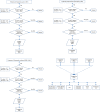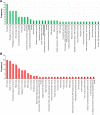Identification of novel drug targets in bovine respiratory disease: an essential step in applying biotechnologic techniques to develop more effective therapeutic treatments
- PMID: 29765203
- PMCID: PMC5944452
- DOI: 10.2147/DDDT.S163476
Identification of novel drug targets in bovine respiratory disease: an essential step in applying biotechnologic techniques to develop more effective therapeutic treatments
Abstract
Background: Bovine Respiratory Disease (BRD) is a major problem in cattle production which causes substantial economic loss. BRD has multifactorial aetiologies, is multi-microbial, and several of the causative pathogens are unknown. Consequently, primary management practices such as metaphylactic antimicrobial injections for BRD prevention are used to reduce the incidence of BRD in feedlot cattle. However, this poses a serious threat in the form of development of antimicrobial resistance and demands an urgent need to find novel interventions that could reduce the effects of BRD drastically and also delay/prevent bacterial resistance.
Materials and methods: We have employed a subtractive genomics approach that helps delineate essential, host-specific, and druggable targets in pathogens responsible for BRD. We also proposed antimicrobials from FDA green and orange book that could be repositioned for BRD.
Results: We have identified 107 putative targets that are essential, selective and druggable. We have also confirmed the susceptibility of two BRD pathogens to one of the proposed antimicrobials - oxytetracycline.
Conclusion: This approach allows for repositioning drugs known for other infections to BRD, predicting novel druggable targets for BRD infection, and providing a new direction in developing more effective therapeutic treatments for BRD.
Keywords: BRD; differential genome analyses; druggability; drugs; pathogenic bacteria; prioritization; targets.
Conflict of interest statement
Disclosure The authors report no conflicts of interest in this work.
Figures






References
-
- Griffin D. Economic impact associated with respiratory disease in beef cattle. Vet Clin North Am Food Anim Pract. 1997;13(3):367–377. - PubMed
-
- Larson R. Effect of cattle disease on carcass traits. J Anim Sci. 2005;83(13 Suppl):E37–E43.
-
- Smith RA. Impact of disease on feedlot performance: a review. J Anim Sci. 1998;76(1):272–274. - PubMed
-
- Wittum TE, Woollen NE, Perino LJ, Littledike ET. Relationships among treatment for respiratory tract disease, pulmonary lesions evident at slaughter, and rate of weight gain in feedlot cattle. J Am Vet Med Assoc. 1996;209(4):814–818. - PubMed
-
- Rajala-Schultz PJ, Torres AH, Degraves FJ, Gebreyes WA, Patchanee P. Antimicrobial resistance and genotypic characterization of coagulase-negative staphylococci over the dry period. Vet Microbiol. 2009;134(1–2):55–64. - PubMed
MeSH terms
Substances
LinkOut - more resources
Full Text Sources
Other Literature Sources
Medical
Molecular Biology Databases

